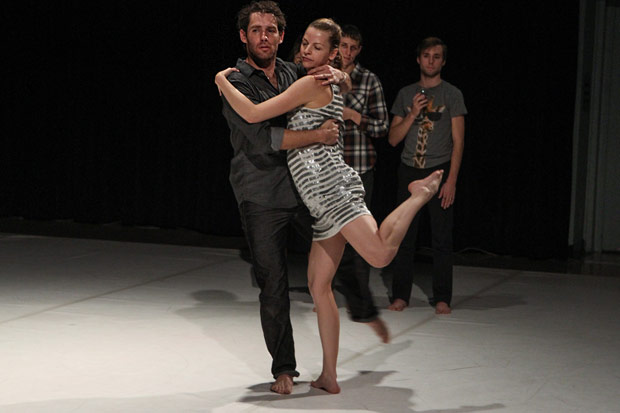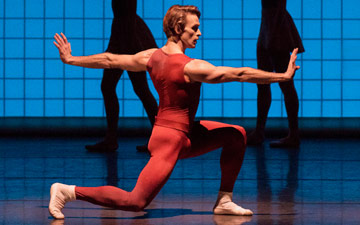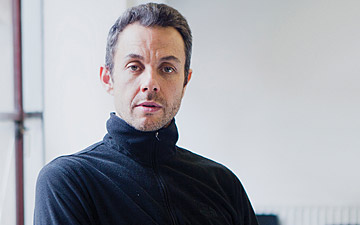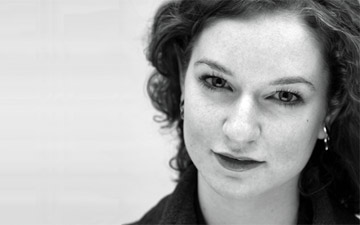
© Julie Lemberger. (Click image for larger version)
Dana Katz (curator)
Out of Israel
Ayala Frenkel: GAZELLE
Uri Shafir: The Koloklum
Tami Stronach Dance: Around the Bend
Sharon Vazanna: A High
New York, 92nd Street Y
15 January 2016
www.92y.org
Show details
There is no denying that Out of Israel is an experimental program, with more than one work vacillating between the realms of dance, dance theater and performance art.
Four works filled the bill Friday night, all chosen by Dana Katz, a New York-based, Israeli choreographer and artistic director of DANAKA Dance.
Katz’s taste, at least right now, is for the visceral. All four pieces featured primal themes and expression, frequently manifested in tense, grappling, nervy works.
Ayala Frenkel’s Gazelle opens with Frenkel placing an iPad and wireless speaker smack in the middle of the stage. Her face is wrapped in a scarf like one of Magritte’s lovers. She clicks play on the iPad and launches the musical accompaniment: Gazelle Twin, aka Elizabeth Bernholz, a UK-based electronica music producer who, coincidentally, also performs with her face covered (usually by a nude stocking cut open around the mouth).
Frenkel embarks on some jagged, choppy movements. Chanelling the uncanny through her shrouded visage, the effect is almost completely dehumanizing, transforming her figure into one of insectoid traits. The rest of her costume is a skirt suit, with a black skirt slashed in four places (center of her backside-all the w ay up, at each side and up the front). The blazer is tightly fastened over a pair of bare breasts.
It is clear Frenkel wants to say something about exposure, of perhaps the female body reduced to nothing but erogenous zones. Several times throughout the work, she holds long poses highlighting these areas, through deep en face penchees and open straddles (she wears black trunks but no tights). She crawls across the stage entirely on her back, leading her motion with her shoulders, hips and finally feet, her legs frequently spread open to accomplish this rather difficult move. After donning a neon yellow sweatshirt and green NBA basketball shorts, she sits down, her face still shrouded. She attaches orange fringe to the hem of the shorts. Doris Day’s “Que Sera Sera” plays, and ends. She plays it a second time and dances around like a young child pretending to be a fine and fancy grown up, the fringe swinging with every exaggerated curtsy and skip. The music ends, her hands are raised, and she pelts out three or four shrill shrieks and the piece is over. Lights out. Maybe Frenkel was going for more depth than the objectification of the female body (and dehumanization of the female sex in broad culture), but if so is severely subdued compared to what appears to be her main observation.
The Koloklum is another piece leaves the viewer on the fence of whether or not it falls into the category of art, performance, dance or none of the above. According to the program notes, “koloklum” means “all or nothing” in Hebrew, and this work choreographed and performed by Uri Shafir is an attempt to “explore a physical state, which sets the body in an impossible task of being everywhere and nowhere at the same time. To express all expressions, to give an expression to ‘nothing.’” Shafir claims the piece is about wanting to “say something clear, and at the same time, it wants to erase itself and disappear.” So, thwarted communication is at the heart of this work. Movement-wise, Shafir chooses to express this with quick, tense pacing and repetitive twitchings. Imagine Tourrette syndrome manifested solely through physical rather than vocal tics. Samuel Barber plays and Shafir fixates on these fast, quick, ditto-like choreography repetitions, and undeniable angst. Many people with a variety of special needs conditions have difficulty communicating their desires because their modes and methods of communication are different from the majority, and not always recognized. A work which appears to draw so heavily on these communication difficulties without acknowledgment or reference, in the name of art, leaves a bad taste in the mouth. Similar examples can be seen in works by many contemporary choreographers; however it is typically presented in less concentrated form.

© Julie Lemberger. (Click image for larger version)
Sharon Vazanna’s A High is another tightly-wound work which focuses on desire. Vazanna, donning metallic aqua high-waist pants, grabs her obliques and twists her body. Her spirals occur on both the lateral and vertical axes to a throbbing electro-nature sound collage. Her body’s sinewy, but also highly contracted, movement transmits the power encapsulated within the human body, its animalism, its instinct, its breadth of sensation. When humans are fully aware of their sensual capacity, it can be overwhelming. A High expresses the body’s vital tension between the anticipation of desire and its fulfilment. Looking at the audience as a predator surveys its prey, Vazanna’s performance strives to be raw but falls short in its overly conscious presentation.
Far and away the highlight of the evening was Tami Stronach Dance’s Around the Bend. If, when Stronach walks onstage, she seems familiar, that’s because she is: she was “The Childlike Empress” from the film “The NeverEnding Story.”
Around the Bend is a dance theater piece, and a fun one. A highlight of this spirited work is a playful pas de deux between Zach Beatty and Darrin Wright, wherein tumbling was interrupted by taut lines, spins and staccato leaps. The work takes place at a party, and a woman tells a simple story about a cat, a rat and a parasite. Dancers give their opinions on the tale – providing a quick, immediate reminder of just how different one human is from another. The entire work is about the middle – not the center, but the middle. Bend asks whether the middle is a muddle or a miracle moment of lucidity.
There is a toast (audience members were given a glass of wine upon entry) to the middle. Stronach asks the crowd to close their eyes and imagine that they are in the exact midpoint of their life. There is an inevitable silence before she chirps “Cheers!” with a smile, and everyone releases an awkward, trepidatious laugh.

















You must be logged in to post a comment.